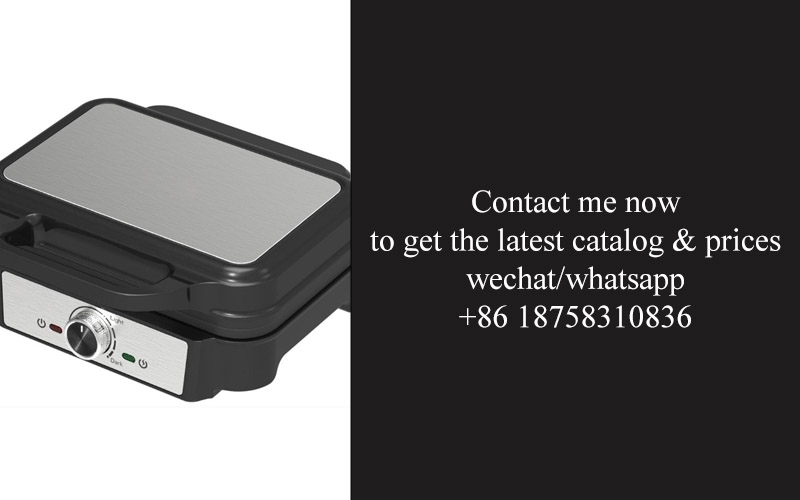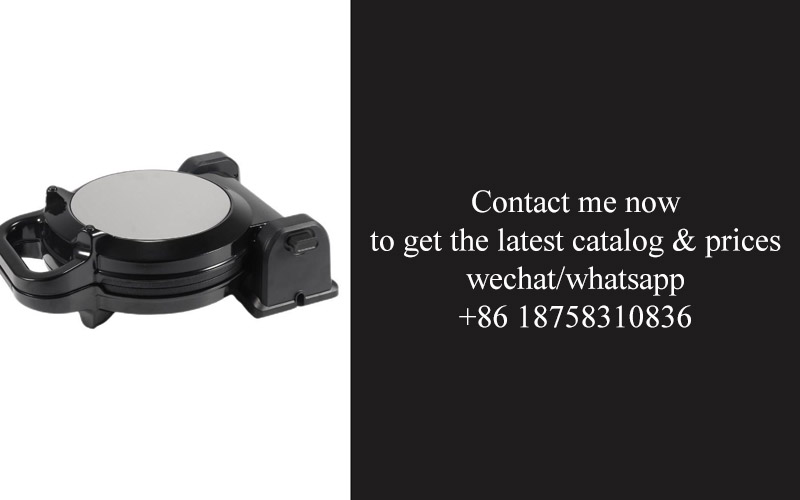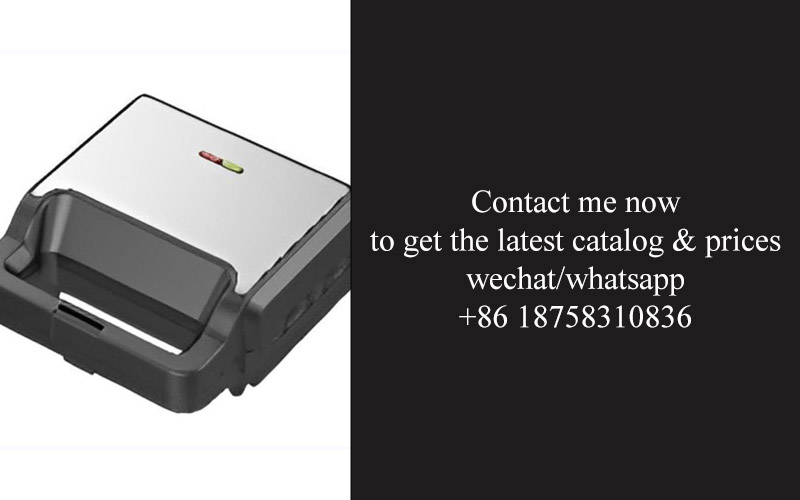Address
304 North Cardinal
St. Dorchester Center, MA 02124
Work Hours
Monday to Friday: 7AM - 7PM
Weekend: 10AM - 5PM
Address
304 North Cardinal
St. Dorchester Center, MA 02124
Work Hours
Monday to Friday: 7AM - 7PM
Weekend: 10AM - 5PM

In a world where technology and craftsmanship intertwine to shape the everyday essentials, the evolution of kitchen appliances has been nothing short of revolutionary. One key player in this transformation is the art of integrated metal stamping, particularly in the production of sandwich plates. These not-so-simple plates are more than just kitchenware; they are a testament to precision engineering and innovative design. As we delve into the intricacies of this process, we uncover a landscape of endless possibilities and the profound impact it has on the kitchenware sector.
In the ever-evolving world of kitchen appliances, the demand for durable and innovative components has surged. One such component that has gained significant traction is the integrated metal stamping for sandwich plates. This technology has emerged as a game-changer in the production of sandwich plates, offering both form and function in an unprecedented manner.
The process of integrated metal stamping involves creating complex shapes and parts by stamping metal sheets using precision tools. In the context of sandwich plates, this technique has revolutionized the way these kitchen essentials are manufactured. It has allowed for the creation of plates that are not only sleek and stylish but also incredibly robust and efficient.
As the popularity of sandwich plates has soared, so too has the need for a manufacturing process that can keep up with the demand. The traditional methods of creating these plates were often time-consuming and lacked the precision required to produce high-quality products. Integrated metal stamping has stepped in to fill this void, offering a solution that is both efficient and scalable.
One of the key benefits of integrated metal stamping is its ability to produce intricate designs and patterns with ease. This has allowed designers and manufacturers to create sandwich plates that stand out from the crowd, offering consumers a wide range of options that cater to their unique tastes and preferences. From minimalist styles to ornate designs, the possibilities are virtually limitless.
Moreover, the process of metal stamping is highly automated, which means that it can produce a large number of sandwich plates in a short amount of time. This efficiency has not only helped to meet the increasing demand for these plates but has also driven down costs, making them more accessible to a broader market.
The precision of integrated metal stamping is another major factor contributing to its rise in sandwich plate production. The process ensures that every plate is uniform in thickness and shape, which is crucial for their durability and performance. Whether it’s for home use or commercial settings, the consistent quality of these plates is something that consumers and businesses alike have come to expect.
In addition to the aesthetic and quality advantages, integrated metal stamping also brings environmental benefits. By producing plates in a more efficient manner, manufacturers are able to reduce waste and energy consumption. This sustainability factor is becoming increasingly important as consumers and businesses alike seek to minimize their environmental impact.
The versatility of metal stamping technology is also noteworthy. It allows for the production of various materials, including stainless steel, aluminum, and other metals, each offering different benefits. For instance, stainless steel sandwich plates are not only durable but also resistant to corrosion, making them a favorite among outdoor enthusiasts and professional chefs.
As the sandwich plate market continues to grow, so too does the competition. Manufacturers are constantly looking for ways to differentiate their products and offer something new to consumers. Integrated metal stamping has provided them with a powerful tool to do just that. It has enabled them to introduce new features and designs that were previously unattainable with traditional manufacturing methods.
Looking ahead, the future of integrated metal stamping in sandwich plate production is bright. Advances in technology are expected to further enhance the capabilities of this process, allowing for even more intricate designs and improved performance. Additionally, as the demand for personalized products increases, the ability to customize sandwich plates using metal stamping will become a key differentiator for manufacturers.
In conclusion, the rise of integrated metal stamping in sandwich plate production is a testament to the power of innovation and technology. It has transformed the way these everyday kitchen items are made, offering consumers a wider variety of high-quality, durable, and stylish options. As the industry continues to evolve, it’s clear that integrated metal stamping will play a pivotal role in shaping the future of kitchenware.

Sandwich plates, at first glance, might seem like a simple kitchen gadget, but they are far more than just a plate. These innovative kitchen tools have been redefining the way we approach meal preparation and presentation. Let’s delve into what makes a sandwich plate stand out from the traditional ones.
The design of a sandwich plate is meticulously crafted to cater to the needs of modern eaters. Unlike your average plate, which typically features a flat surface, sandwich plates are often contoured to accommodate the height of a sandwich, ensuring that every bite is held securely in place. This thoughtful design not only enhances the eating experience but also adds a touch of sophistication to the kitchenware itself.
One of the key features of sandwich plates is their ability to serve as a multi-functional tool. These plates can be used to display sandwiches, keeping them fresh and appealing until the moment they’re devoured. The elevated edges prevent any drips or spills, making them perfect for serving open-faced sandwiches or those with creamy fillings. This dual-purpose aspect of sandwich plates has become a favorite among food enthusiasts and culinary professionals alike.
The materials used in sandwich plate production are another factor that sets them apart. High-quality ceramics, stainless steel, and even bamboo are common choices, each offering unique benefits. Ceramics provide a classic, elegant look that complements any kitchen aesthetic, while stainless steel is both durable and easy to clean. Bamboo, on the other hand, brings a natural, eco-friendly element to the table, appealing to environmentally conscious consumers.
The rise of the sandwich plate has also been influenced by the growing popularity of fast-casual dining. As people seek out convenient yet high-quality meal options, sandwich shops and cafes have become a staple in urban landscapes. These establishments rely on sandwich plates to present their creations in an attractive and appetizing manner, encouraging customers to take a bite. The visual appeal of a sandwich plate can be a deciding factor in a customer’s choice of meal.
Moreover, sandwich plates have become a favorite among food bloggers and influencers. These individuals often showcase their culinary creations on social media, and a beautifully presented sandwich plate can elevate the visual storytelling of a dish. The unique design of these plates has become a go-to tool for those looking to capture the perfect photo or video, making them an essential part of the modern food photography toolkit.
Another interesting aspect of sandwich plates is their versatility in terms of customization. Many manufacturers offer personalized options, allowing customers to choose from a variety of colors, patterns, and even engraved messages. This personal touch not only adds a unique flair to the kitchen but also serves as a conversation starter among guests.
The evolution of the sandwich plate has also led to the creation of specialized variations. For instance, there are sandwich plates designed specifically for sliders or bite-sized sandwiches, ensuring that each mini-sandwich is perfectly proportioned. There are also plates with built-in utensil holders, making it easier to enjoy a meal without the need for additional tableware.
In the realm of food presentation, sandwich plates have found their niche. They offer a balance between functionality and aesthetics, making them a must-have for anyone who appreciates a well-prepared meal. The convenience of being able to serve and eat a sandwich without worrying about the mess is a game-changer for busy individuals and families.
Furthermore, sandwich plates have become a symbol of culinary innovation. As chefs and home cooks continue to experiment with new flavors and ingredients, the sandwich plate provides a canvas for these creative endeavors. It’s a testament to the fact that even the simplest of kitchen tools can inspire culinary greatness.
In conclusion, sandwich plates are more than just a plate. They are a reflection of the evolving culinary landscape, offering convenience, style, and functionality that has captured the hearts and taste buds of many. Whether you’re a sandwich shop owner, a food influencer, or just someone who loves to eat well, a sandwich plate is a kitchen essential that adds a layer of sophistication to every meal.

In the realm of modern kitchen appliances, the role of integrated metal stamping is both subtle and profound. This precision engineering process has revolutionized the way we think about the components that make up our kitchen gadgets, with sandwich plates playing a pivotal role.
The precision of metal stamping ensures that the components of kitchen appliances are not just durable but also optimized for function. Sandwich plates, in particular, are a testament to this. These plates are often used in cooktops, ovens, and other appliances where heat distribution and structural integrity are critical.
One of the key benefits of integrated metal stamping in sandwich plates is the consistency of the material properties. The process allows for the creation of plates with uniform thickness and precise dimensions, which is essential for even heat transfer and resistance to warping or bending under heat. This level of precision is often unattainable through traditional metalworking methods.
The stamping process also enables the integration of various features into a single piece of metal. For example, the edges of a sandwich plate can be designed with specific contours to enhance air flow and reduce steam buildup during cooking. This kind of innovation is possible because the metal can be shaped into complex geometries with ease, allowing for a more efficient and effective appliance design.
Another important aspect of integrated metal stamping is the cost-effectiveness it brings to the production process. By reducing the need for additional components and assembly steps, the overall cost of manufacturing is significantly lowered. This cost savings can be passed on to consumers, making high-quality kitchen appliances more accessible.
In terms of sustainability, the use of metal stamping in sandwich plates is also advantageous. The process minimizes waste as it allows for the creation of intricate shapes without the need for excessive material. Additionally, the durable nature of stamped metal means that appliances are less likely to need frequent replacement, contributing to a reduction in the environmental impact over time.
The design flexibility of metal stamping is another factor that cannot be overlooked. Engineers can experiment with different materials, coatings, and finishes to tailor the sandwich plates to specific appliance requirements. For instance, certain appliances might benefit from a non-stick coating, while others may require a special heat-resistant finish. The stamping process accommodates these variations seamlessly.
Moreover, the consistency and reliability of stamped components contribute to the longevity of kitchen appliances. A sandwich plate that is precisely stamped to withstand high temperatures and maintain its shape over time means that the appliance it is part of will perform consistently, providing a reliable cooking experience.
In the realm of safety, the role of integrated metal stamping is equally crucial. The precise manufacturing of sandwich plates ensures that they meet stringent safety standards, reducing the risk of accidents or malfunctions. This is particularly important in kitchen appliances where heat and fire are involved.
The integration of metal stamping into sandwich plates has also led to advancements in the aesthetics of kitchen appliances. The sleek, uniform look of stamped metal contributes to the modern, clean design of many high-end appliances. This not only appeals to consumers who value aesthetics but also helps to establish a brand’s identity in a highly competitive market.
In summary, the role of integrated metal stamping in modern kitchen appliances, particularly in the production of sandwich plates, is multifaceted. It enhances the performance, durability, and safety of appliances while also driving innovation and cost efficiency. As technology continues to evolve, the importance of precision metal stamping in shaping the future of kitchen appliances will undoubtedly grow.

In the ever-evolving world of kitchen appliances, the quest for innovation and enhanced performance is relentless. Metal stamping, a foundational process in the production of various kitchen components, has seen remarkable advancements. Here’s a closer look at some of the key innovations shaping the metal stamping industry for better performance.
Precision Engineering Meets Metal StampingThe precision of metal stamping has reached new heights with the advent of advanced machinery and techniques. High-tech CNC machines are now capable of producing intricate patterns and shapes with unparalleled accuracy. This precision not only ensures that each component fits perfectly within the appliance but also contributes to the overall durability and efficiency of the product.
Material Science IntegrationThe integration of material science into metal stamping has been a game-changer. By understanding the properties of different metals and alloys, engineers can select the perfect material for each application. For instance, stainless steel is favored for its resistance to corrosion and durability, while aluminum offers a lighter weight option for energy efficiency. The right material choice can significantly impact the performance and lifespan of kitchen appliances.
Automated Production LinesAutomation has revolutionized the metal stamping process. Modern production lines are equipped with robotics and AI-driven systems that can perform complex tasks with speed and consistency. This not only increases output but also reduces the likelihood of errors. Automated stamping machines can handle high-volume production, ensuring that each component meets the stringent quality standards required for modern kitchen appliances.
Improved Surface Finishing TechniquesThe surface finish of metal components is crucial for both aesthetics and functionality. Innovations in surface finishing techniques have allowed for more durable and visually appealing finishes. Anodizing, for example, provides a protective layer that enhances corrosion resistance and improves the overall look of the metal. Other techniques like powder coating and electroplating offer a wide range of color options and finishes that can be tailored to meet the latest design trends.
Customization at ScaleOne of the most significant innovations in metal stamping is the ability to customize components at scale. Through the use of advanced software and 3D printing technology, manufacturers can create custom stamping dies that cater to specific design requirements. This level of customization allows for the production of unique and specialized components that can enhance the performance of kitchen appliances, whether it’s a sleeker design or a more efficient part.
Energy-Efficient Stamping ProcessesAs sustainability becomes a key concern in manufacturing, energy-efficient stamping processes are gaining traction. Innovations in die design and material selection aim to reduce energy consumption during the stamping process. For example, using thinner materials can decrease the amount of energy required to form the metal, leading to cost savings and a smaller environmental footprint.
Enhanced Safety FeaturesSafety is paramount in kitchen appliances, and metal stamping plays a critical role in ensuring that these features are integrated effectively. Innovations in stamping techniques have allowed for the creation of components that can withstand high temperatures, electrical currents, and mechanical stress. From heat-resistant handles to electrically insulated parts, these advancements contribute to the safety and reliability of modern kitchen appliances.
Integration with Smart Kitchen TechnologyThe integration of metal stamping with smart kitchen technology is another area of innovation. As appliances become more connected and interactive, the metal components that make up these devices must be robust and capable of withstanding the demands of smart functionality. Stamping innovations are making it possible to produce lightweight yet strong components that can support the latest smart kitchen features, such as touch controls and wireless connectivity.
In conclusion, the innovations in metal stamping are not just about making kitchen appliances look better; they are about making them perform better, last longer, and integrate seamlessly with the evolving landscape of kitchen technology. From precision engineering to sustainable practices, these advancements are shaping the future of kitchen appliances and the experiences they provide to consumers.

In the realm of kitchen appliances, sandwich plates have emerged as a staple, and the role of integrated metal stamping in their production is pivotal. This technique offers several advantages that not only enhance the performance of sandwich plates but also contribute to the overall quality and efficiency of modern kitchen appliances.
Precision and ConsistencyOne of the standout benefits of integrated metal stamping is the unparalleled precision it brings to the manufacturing process. The method involves using a stamping press to form metal sheets into complex shapes with high accuracy. This precision ensures that each sandwich plate is uniform in size and shape, which is crucial for consistent performance and durability. The tight tolerances achieved through metal stamping mean that the plates fit seamlessly into various appliances, from ovens to grills, without any risk of malfunctions due to misalignment.
Material EfficiencyMetal stamping is a highly efficient process when it comes to material usage. By cutting out excess material during the stamping process, manufacturers can reduce waste and optimize material utilization. This efficiency is particularly important for sandwich plates, which often require multiple layers of metal to create their unique construction. With integrated metal stamping, the ability to create intricate patterns and layering without excess material ensures that the final product is not only functional but also environmentally friendly.
Durability and StrengthThe strength of sandwich plates is a key factor in their performance, and integrated metal stamping plays a significant role in enhancing this aspect. The process allows for the creation of plates with increased thickness and structural integrity, which can withstand the rigors of daily use in a kitchen. The metal’s inherent strength is further amplified by the stamping process, which can create features like reinforced edges and ribs that distribute stress more evenly across the plate. This durability means that sandwich plates made through metal stamping can last longer, reducing the need for frequent replacements and contributing to the sustainability of kitchen appliances.
Customization and Design FlexibilityIntegrated metal stamping offers a high degree of design flexibility, allowing manufacturers to create sandwich plates with intricate patterns and unique features. This customization is not just about aesthetics; it can also improve the functionality of the plate. For example, a sandwich plate with strategically placed dimples can enhance heat distribution, making it more effective for cooking tasks. The ability to stamp various metals, including stainless steel, aluminum, and copper, opens up a world of possibilities for both design and performance enhancements.
Cost-EffectivenessWhile the initial investment in metal stamping equipment can be significant, the long-term cost benefits are substantial. The efficiency of the process reduces labor costs, as the stamping machines can produce a high volume of plates in a short amount of time. Additionally, the reduced material waste and improved durability of the stamped parts mean lower maintenance and replacement costs. For sandwich plates, which are often used in commercial settings where durability is paramount, this cost-effectiveness becomes even more pronounced.
Quality Control and ReliabilityThe consistency and repeatability of the metal stamping process contribute to a high level of quality control. Each sandwich plate is produced to the same exacting standards, ensuring that every unit meets the required specifications. This reliability is crucial in kitchen appliances, where the safety and performance of the components are paramount. The ability to monitor and adjust the stamping process in real-time also allows for quick corrections and ensures that only high-quality sandwich plates leave the production line.
Innovation and Future PotentialAs technology advances, the potential for innovation in metal stamping for sandwich plates continues to grow. New materials, such as advanced alloys, can be stamped to create plates with improved thermal conductivity and corrosion resistance. Additionally, the integration of smart technologies, such as sensors within the stamped plates, could revolutionize the way kitchen appliances interact with their users. The future of integrated metal stamping in sandwich plate production looks promising, with endless possibilities for enhancing the performance and user experience of modern kitchen appliances.

The demand for sandwich plates has been on the rise, reflecting a shift in consumer preferences towards convenience and functionality in kitchenware. The market insights into the sandwich plate industry highlight several key trends that are shaping its growth and demand.
Customers are increasingly seeking products that not only serve their immediate needs but also offer versatility and durability. This trend has led to a surge in demand for sandwich plates that are not just simple containers but are designed to enhance the overall meal experience. From lunch boxes to bento boxes, the market for these innovative plates has expanded significantly.
One notable trend is the integration of eco-friendly materials and sustainable practices into sandwich plate design. Consumers are becoming more environmentally conscious, and this shift is reflected in the popularity of sandwich plates made from recycled materials or those that are biodegradable. Companies that have embraced this trend are finding a growing market segment that values sustainability.
The growth of the sandwich plate industry is also being driven by demographic changes. As the global population becomes more urbanized, there’s an increase in the number of people living in small spaces, such as apartments and condos. This demographic favors compact, easy-to-store, and portable sandwich plates, which are becoming increasingly popular.
The rise of health-conscious consumers has also played a significant role in the demand for sandwich plates. These individuals are looking for meal options that are both nutritious and convenient, and sandwich plates provide a perfect solution. They allow for portion control, easy clean-up, and the ability to pack a variety of ingredients, from fresh fruits and vegetables to lean proteins.
Another factor influencing the market is the globalization of food culture. People are more open to trying different cuisines, and sandwich plates offer a way to replicate or enjoy these diverse dishes at home. This cultural exchange has led to a demand for sandwich plates that can accommodate various types of fillings, from traditional American sandwiches to international cuisine.
The sandwich plate industry is also seeing advancements in technology that are driving demand. Smart plates with features like temperature control and insulation are becoming more common, offering consumers the ability to maintain the desired temperature of their food for longer periods. These innovations cater to the busy lifestyles of today’s consumers, who appreciate the convenience of technology integrated into everyday items.
In terms of regional demand, there are notable differences across the globe. In North America and Europe, there’s a strong preference for high-quality, aesthetically pleasing sandwich plates that often double as serving dishes. Meanwhile, in Asia, there’s a greater focus on functionality and portability, with a preference for lightweight and durable materials.
The growth trends in the sandwich plate industry are further bolstered by the rise of e-commerce. Online sales have made it easier for consumers to discover and purchase a wide range of sandwich plates, from budget-friendly options to premium, designer pieces. This has expanded the market reach and increased accessibility to a broader audience.
In conclusion, the demand and growth trends in the sandwich plate industry are multifaceted, driven by a combination of consumer preferences, technological advancements, and cultural shifts. As the market continues to evolve, it’s likely that we’ll see even more innovative designs and features that cater to the diverse needs and tastes of consumers worldwide.

In the realm of kitchen appliance manufacturing, the integration of metal stamping techniques has revolutionized the production of sandwich plates. Let’s delve into some notable case studies where this technology has been successfully implemented.
One such case is the partnership between a leading kitchenware manufacturer and a specialized metal stamping company. The manufacturer was facing challenges in producing sandwich plates with consistent quality and precision. The traditional methods were time-consuming and prone to errors.
The metal stamping company introduced a new approach, utilizing advanced machinery and innovative designs. They crafted custom molds that allowed for the precise formation of the sandwich plates. The result was a significant reduction in production time and a marked improvement in the quality of the final product.
Another instance involves a small startup that specializes in eco-friendly kitchenware. They sought to create a line of sandwich plates that were both durable and sustainable. By employing integrated metal stamping, the startup was able to develop plates that were not only lightweight but also had a unique, sleek design.
The process involved creating a stamping die that could form the plates from recycled stainless steel. This not only minimized waste but also enhanced the strength and longevity of the plates. The startup’s innovative approach caught the attention of eco-conscious consumers, leading to a surge in demand.
A global appliance brand also turned to integrated metal stamping to revamp its sandwich plate collection. The brand was looking to refresh its product line with modern, stylish designs that also offered practicality. The metal stamping process allowed for intricate patterns and seamless transitions between materials, creating a visually stunning yet functional product.
The stamping process also enabled the brand to incorporate new features such as non-slip bases and heat-resistant handles. This was achieved by integrating various components within the stamping process, ensuring that each plate was a cohesive unit from the start.
In yet another case, a mid-sized kitchenware manufacturer was struggling to keep up with the demand for custom designs. The company needed a solution that could cater to a diverse range of customer preferences without compromising on quality or efficiency. Integrated metal stamping provided the answer.
The manufacturer collaborated with a stamping specialist to develop a flexible system that could produce a wide array of sandwich plates. This system allowed for quick adjustments to the molds, enabling the manufacturer to respond swiftly to changing market trends and customer requests.
The use of integrated metal stamping in these case studies has demonstrated its versatility and effectiveness. From large-scale production to bespoke designs, the technology has proven to be a game-changer in the sandwich plate industry. It has allowed manufacturers to push the boundaries of creativity while maintaining high standards of quality and efficiency.
The success of these case studies underscores the importance of integrated metal stamping in the kitchen appliance sector. As the industry continues to evolve, it’s clear that this technology will play a pivotal role in shaping the future of sandwich plates and other kitchenware products.

In the ever-evolving landscape of kitchen appliance manufacturing, the future of sandwich plate metal stamping technologies holds immense promise. As we delve into the prospects that lie ahead, several key developments are poised to redefine the industry. From advancements in material science to the integration of smart technology, the following insights paint a picture of a dynamic and innovative future.
The integration of lightweight metals, such as aluminum and stainless steel, has been a game-changer in the sandwich plate industry. These materials offer a delicate balance between strength and durability, allowing for the creation of plates that are both functional and aesthetically pleasing. As these metals continue to be refined, we can expect even greater efficiencies in manufacturing and performance.
The rise of 3D printing and additive manufacturing techniques is another area that promises to revolutionize sandwich plate metal stamping. These technologies enable the creation of complex geometries and customized designs that were once impossible to achieve with traditional stamping methods. The ability to produce unique, one-off pieces or batches tailored to specific customer needs is a significant leap forward for the industry.
Smart materials, which can change shape, respond to temperature, or even communicate with other devices, are also catching the attention of manufacturers. Incorporating these into sandwich plates could lead to innovative products that not only serve a functional purpose but also offer a level of connectivity and convenience previously unseen in kitchenware.
Energy efficiency is a growing concern, and the future of sandwich plate metal stamping may involve the development of plates that can harness and store energy. This could mean integrating solar panels or kinetic energy systems into the design, turning everyday kitchenware into a source of power.
Innovation isn’t just about materials and technology; it’s also about the way products are produced. Automation and robotics are already making their mark in the industry, and this trend is expected to continue. The use of advanced robotics in the stamping process can lead to higher precision, reduced waste, and increased productivity, all of which contribute to a more sustainable and cost-effective manufacturing process.
The environmental impact of manufacturing processes is also a focal point. As awareness of sustainability grows, the industry is likely to see a shift towards greener practices. This could involve the use of recycled materials, the reduction of energy consumption, and the development of more efficient recycling methods for metal stamping waste.
The future of sandwich plate metal stamping also hinges on the evolving consumer preferences. As health and wellness become more important, we may see a surge in demand for plates that are not only functional but also promote healthy eating habits. This could include plates with portion control features or those made from materials that are free from harmful chemicals.
Collaboration between designers, engineers, and manufacturers will be crucial in shaping the future of sandwich plate metal stamping. By pooling their expertise, these professionals can push the boundaries of what’s possible, creating products that are not just practical but also innovative and exciting.
Lastly, the integration of AI and machine learning into the design and production process is a trend that’s likely to gain momentum. These technologies can analyze vast amounts of data to optimize designs, predict failures, and improve efficiency. The result could be a more robust and reliable product line that meets the needs of both manufacturers and consumers.
In summary, the future of sandwich plate metal stamping is bright and filled with possibilities. As the industry continues to innovate, we can anticipate a wave of new technologies and designs that will transform the way we interact with our kitchenware. Whether it’s through enhanced functionality, sustainability, or connectivity, the next generation of sandwich plates is set to surprise and delight.

The integration of metal stamping into the kitchenware sector has undeniably left an indelible mark. From enhancing the durability of everyday utensils to revolutionizing the aesthetics of high-end cookware, this technology has become a cornerstone in the industry. Let’s delve into the transformative impact it has had on the market.
Metal stamping has introduced a level of precision and efficiency that was once unattainable. It has allowed manufacturers to produce intricate designs and patterns that not only serve a functional purpose but also elevate the visual appeal of kitchenware. The ability to create seamless and uniform surfaces has been a game-changer, as it reduces the likelihood of leaks and improves the overall user experience.
The adoption of integrated metal stamping has also led to significant cost savings. By streamlining the production process and reducing the need for additional assembly steps, manufacturers have been able to cut down on labor and material costs. This cost-effectiveness has made high-quality kitchenware more accessible to a broader consumer base, fostering market growth and competition.
Innovation in metal stamping has not only focused on efficiency and cost reduction but also on sustainability. The use of recycled materials and the development of eco-friendly production methods have made the process more environmentally conscious. This shift towards sustainability has resonated with consumers who are increasingly aware of the importance of reducing their carbon footprint.
Case in point, the introduction of lightweight yet robust metal stamping techniques has allowed for the creation of cookware that is both energy-efficient and durable. These advancements have not only improved the performance of kitchen appliances but have also extended their lifespan, reducing the frequency of replacements and further contributing to sustainability efforts.
The integration of metal stamping into kitchenware has also spurred the development of new product categories. The ability to stamp metal into unique shapes and sizes has opened up possibilities for specialized cookware, such as induction cooktops with precise heating elements and non-stick pans with intricate patterns that promote even heat distribution.
Moreover, the versatility of metal stamping has enabled the customization of kitchenware. Manufacturers can now offer personalized designs, catering to the unique tastes and preferences of consumers. This level of customization has not only increased customer satisfaction but has also driven brand loyalty and market differentiation.
Looking ahead, the future of metal stamping in the kitchenware sector is poised for even greater advancements. As technology continues to evolve, we can expect to see further innovations that will push the boundaries of what is possible in kitchenware design and functionality.
One such innovation could be the integration of smart technology into metal-stamped kitchenware. Imagine a non-stick pan that not only provides optimal cooking temperatures but also alerts you when it’s time to flip your food or when it’s time to clean. The possibilities are endless, and the potential for such integration is vast.
Another area of growth is the exploration of new materials. As we move towards a more sustainable future, the development of metal alloys that are both durable and environmentally friendly will be crucial. These materials could offer enhanced performance while minimizing the environmental impact of production.
The impact of integrated metal stamping on the kitchenware sector is undeniable. It has transformed the way we think about cookware, from its design and functionality to its sustainability and accessibility. As the industry continues to evolve, it’s clear that metal stamping will remain a pivotal technology, shaping the future of kitchenware and the culinary experiences it enables.